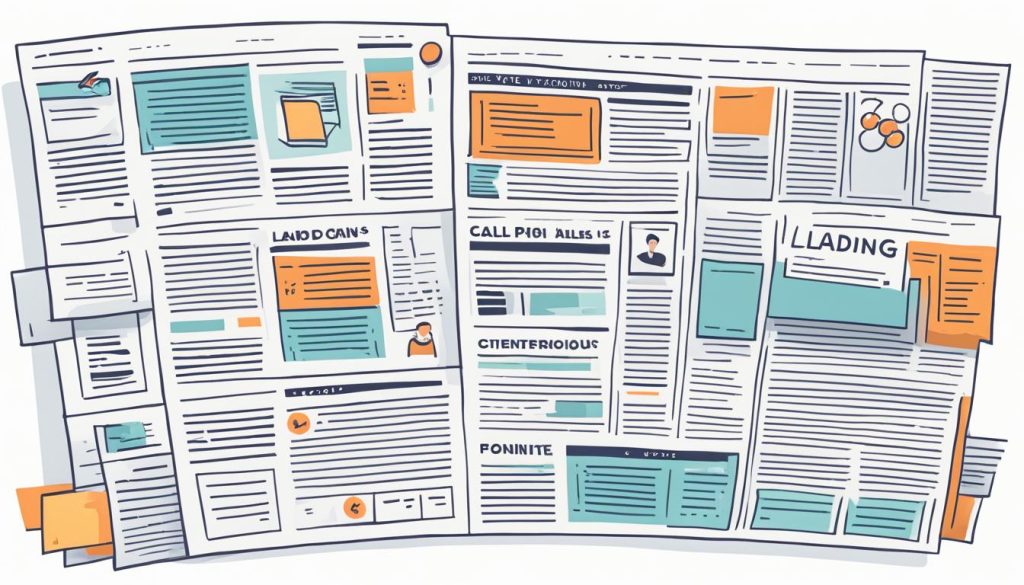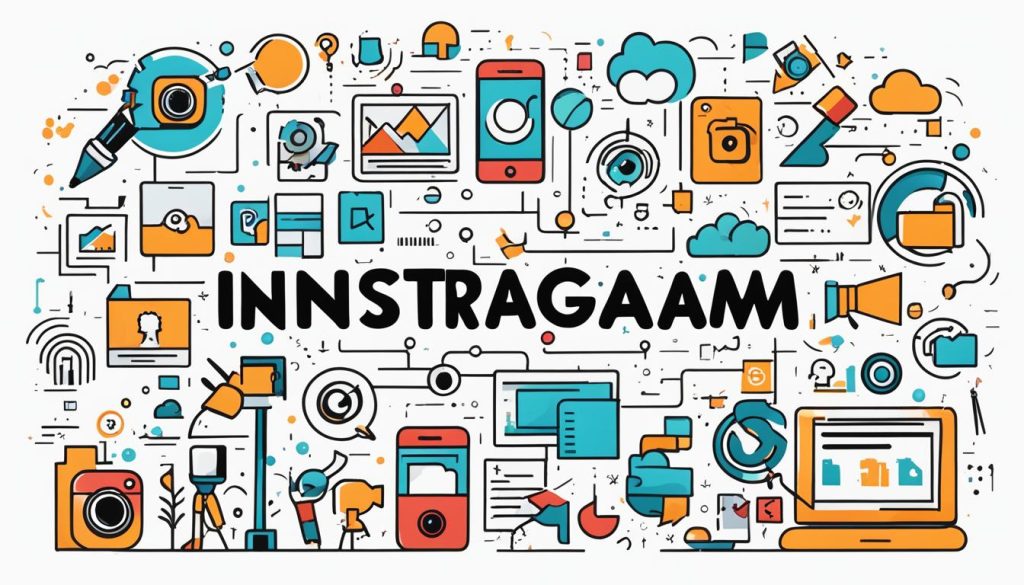Whether you are an established enterprise or a burgeoning start-up, understanding the nuances of landing page strategies is quintessential for enhancing your lead capture and bolstering conversion rates. As a linchpin in your marketing strategy, your landing page must be engineered with precision, purpose, and a focus on directing potential customers through a seamless path from their initial curiosity to the intentional action of providing their personal details. In this digital age, your landing page is not just a mere front; it’s the gateway that converts web traffic into tangible growth for your business.
Key Takeaways
- Optimise your landing page to centralise the user’s journey, from the first click to lead capture.
- Cultivate high conversion rates by constructing landing pages that embody clarity, relevance, and responsive design.
- Employ strategic use of compelling calls-to-action (CTAs) that resonate with your target audience.
- Understand the importance of lead form position and simplicity to avoid overwhelming prospects.
- Adapt your landing page content regularly through data analysis to maintain and improve its performance.
- Integrate a solid marketing strategy that ensures your landing page aligns with your brand’s mission and customer expectations.
The Critical Role of Landing Pages in Digital Marketing
Anchoring the marketing funnel with prowess, landing pages epitomise the very essence of conversion strategies. They are not just static web pages, but powerful marketing tools fashioned to enhance user experience and whisk visitors through the decision-making journey. With fine-tuned landing page optimization, businesses sculpt the path that leads to the apex of the marketing funnel: conversion.
Defining the Purpose and Power of a Landing Page
The singular purpose of a landing page is to transmute curiosity into action. It’s the digital handshake between a business and prospective customer where first impressions are moulded. Here, visitors are greeted with targeted messaging aligned with their expectations, urging them to offer contact information in exchange for a service or content of value. The efficacy of this transaction hinges on refined user experience, where the design, content, and functionality converge to achieve a singular goal – capture leads.

Eliminating Distractions to Heighten User Engagement
Distractions are the adversaries of focus. To escalate user engagement, a landing page must be a clean slate, devoid of disruptive elements. Navigation bars, extraneous links, and unrelated information can fragment attention, thereby diluting the potency of the user experience. By stripping away these distractions, a landing page fortifies the user’s attention on a lucid call-to-action (CTA), magnifying the likelihood of fulfilling the intended conversion goal.
Assess your landing page; does it encapsulate a seamless pathway for the user? Or does it perforate attention with escape routes? Examine the components through the lens of visitor intent and ensure every element consolidates rather than disperses, the user’s trajectory towards conversion.
Landing Page Strategies for Lead Capture
Ensuring robust user engagement is pivotal when designing a landing page aimed at maximising lead capture. A tactical approach to website design can drive your customer journey towards successful conversion. Imagine each element of your landing page as a cog in a well-oiled machine, where the headline, graphics, and call-to-action (CTA) work in sync to entice users to surrender their personal details willingly and, ultimately, enhance your conversion rates.

Begin by delving into the psychology behind user interaction. A compelling, benefit-focused headline is the gateway to user interest. It must resonate instantly with the visitor’s needs, promising solutions and crafting a narrative that aligns seamlessly with their expectations and desires.
Selecting imagery that aligns with the messaging is equally essential. Visual cues act as silent ambassadors of your brand identity, solidifying the message delivered through text. The strategic placement of these elements not only enhances aesthetic appeal but also guides users smoothly through the information pipeline, culminating in the pivotal act of information submission.
Captivating imagery coupled with concise, impactful copy can multiply your lead generation efforts exponentially.
- Align your graphics with the user’s aspirations and pain points.
- Use a colour palette that evokes the right emotions and actions.
- Place your lead form strategically to make submission a natural next step.
Below is a snapshot of how various elements of a landing page can contribute to user engagement and encourage lead capture:
| Component | Purpose | Impact on User Engagement |
|---|---|---|
| Headline | To capture attention swiftly and convey the core benefit | Intrigues and maintains visitor interest, prompting them to explore further |
| Imagery | To visually communicate the brand message | Enhances the narrative and aids emotional connection with the offering |
| Copy | To inform and persuade the visitor to act | Builds trust and guides users towards the lead form with a clear narrative |
| Form Placement | To establish a clear, uninterrupted path to conversion | Directs the user naturally towards sharing their details without distractions |
| Call-to-Action | To be a clear, stand-out invitation for visitors to take the next step | Encourages immediate action and reduces hesitation at the point of commitment |
The core of lead-capture optimisation lies in creating a seamless and intuitive user experience that smoothly transitions visitors from interest to action. Keeping your customer journey central to your landing page design process will ensure that each visitor is met with a carefully tailored experience, encouraging not just engagement, but conversion, loyalty, and advocacy.
Best Practices for High Conversion Rates
Securing high conversion rates is a sought-after goal in the realm of digital marketing. To achieve this, headline writing plays a crucial role; it must quickly convey the core benefits and draw in your audience. It’s not just about crafting the headline, however, as other elements come together to form a harmonious and persuasive landing page.
To provide actionable insights into the mechanisms behind successful landing pages, let us delve into the best practices that are central to optimising your online presence for elevated conversions. These practices centre around a balance of well-crafted content, imagery, and form design, all of which collaborate to ensure the visitors not only arrive but stay and convert.
- Headline That Resonates: Your headline should immediately articulate the unique value proposition, promising a clear benefit that meets your audience’s expectations.
- Captivating Imagery: Select visuals that strengthen your message and emotionally connect with the viewer. These images should not only be appealing but purposeful, accentuating the impact of your offer.
- Clear Copywriting: Write clear and engaging content that guides the user towards the action you desire them to take, with every word serving a strategic purpose towards conversion.
- Above the Fold: Position your form in a prominent location above the fold to ensure it’s one of the first things a visitor sees without needing to scroll.
- Compelling Calls-to-Action: Feature stand-out CTAs that are visually distinctive, persuasive in language, and instantaneous in prompting an action.
Remember, the experience on your landing page should flow seamlessly from start to finish, reinforcing both the relevance and the appeal of the offer made. By focusing on responsive and search-optimised page designs, you cater to diverse users – from those casually browsing to the determined seekers of solutions. Your form should be the nexus of simplicity and function, welcoming users to take that final step towards becoming leads with minimal effort and maximal incentive.
Adhering to these best practices will not only increase your conversion rates but also position your brand as one that truly understands and values its audience’s online experience. Keep these principles in mind as you fortify the gateway of your digital marketing funnel and watch your engagement metrics soar.
Designing for The Customer Journey: Insights into User Behaviour
Embarking on the design of a digital experience, an acute focus on user pathways is vital for steering the customer journey towards success. To truly enhance visitor engagement and lead nurturing, one must delve deeply into website analytics and decipher the narratives these numbers tell. By exploring the wealth of data, your aim is to craft an online environment that resonates with your audience’s expectations and propels them through a seamless navigational experience.

Understanding the User’s Pathway and Experience
Every click, every scroll signifies a chapter in the user’s story. Whether they’re a first-time visitor or a returning customer, understanding the intricate details of how they interact with your site is paramount. Recognising where they stem from – be it via organic search results, social media links or email campaigns – provides context to their needs and state of mind. Utilising this information effectively paves the way for a tailored approach that speaks directly to the user’s phase in the buying cycle.
Optimising for Visitor Retention and Satisfaction
The layout and structure of your digital offerings play a critical role in holding attention and reinforcing satisfaction. Key information must be directly in view – think ‘above the fold’ – ensuring that essential messages are immediately comprehensible. A layout primed for easy scanning accommodates even the most hurried visitors, while a familiar, intuitive structure promotes ease of use. By prioritising these elements, you forge a path of least resistance, leading your users expeditiously to the end goal: conversion.
- Maintain key messages and calls-to-action above the fold
- Deploy a familiar layout for immediate recognition and comfort
- Streamline content to eliminate friction and encourage user progression
Enhancing Lead Forms for Maximum Effectiveness
As you refine your website’s content and work towards optimising the conversion funnel, it is vital to harness user feedback to polish the mechanism that acts as the front line for lead capture: the lead form. With minimalist design in focus, here’s how you can enhance your lead forms to ensure they contribute positively to your marketing strategies.

Begin by evaluating what essential information is actually required from your prospects. Information overkill can deter potential leads, whereas a concise form optimises user experience and conversion rates. Your lead form strategy should mirror the complexity of your conversion funnel. Here’s a straightforward approach to consider:
- If the user is new to your brand, request the bare minimum: usually a name and an email address suffices.
- For users who are further along in the funnel and exhibit a higher level of brand trust, you can request more detailed information.
- Always align the information you ask with the value of your offering – balance is key to the user’s perception of fairness in exchange.
Additionally, pay close attention to the user-friendly aspects of form design. Small tweaks such as auto-completing fields and clear error messages go a long way in solidifying user trust and eliminating frustration, thus maximising lead form effectiveness.
| Form Element | Purpose | User Benefit |
|---|---|---|
| Short Fields | Minimise user effort | Quick and easy completion |
| Auto-Complete Functions | Speed up form completion | Reduces repetitive typing |
| Clear Error Messages | Provide immediate feedback | Helps to correct errors without confusion |
| Multi-Step Forms | Breakdown complex information requests | Less intimidating, gives sense of progress |
Fine-tuning your approach to information collection is both art and a science. Rigorous analysis through tracking website interactions and assessing user feedback allows for iterative improvements that align your landing page content and form design with your audience’s preferences and expectations. When you strike the right balance, you’ll notice not only an uptick in lead generation but also an enhanced quality of the leads you attract.
The Importance of A/B Testing in Landing Page Optimisation
As you delve into the realm of digital marketing, A/B testing emerges as a critical tool for refining your landing pages. This methodical approach to testing allows you to pit two versions of a page against each other, directly measuring their effectiveness in real time. By embracing this practice, you can determine the most effective elements that lead to higher performance metrics and encourage positive user behaviour. The meticulous analysis of A/B testing data provides a window into the preferences and actions of your audience, laying the groundwork for robust, data-driven optimisation strategies.
Implementing A/B Testing for Performance Metrics Analysis
To understand the impact of specific changes on your landing page, A/B testing serves as your investigative lens. By implementing A/B tests, you can analyse key performance metrics like conversion rates, bounce rates, and click-through rates with precision. This analysis facilitates a deeper understanding of which page elements resonate best with your audience and drive the desired outcomes. Consequently, A/B testing propels your landing page’s performance to new heights by ensuring that every tweak and tune-up is substantiated by concrete, measurable results.

Gleaning Actionable Insights from User Interactions
The ultimate goal of A/B testing is not merely to observe differences in performance metrics but to extract actionable insights from real user interactions. By studying how users interact with varying elements—such as headlines, form fields, and CTAs—you can begin to paint a clear portrait of user behaviour. These insights inform strategic decisions, enabling you to enhance the user experience, streamline the conversion path, and ultimately optimise your landing page for better visitor engagement and higher conversion rates.
| Element Tested | Version A | Version B | Outcome |
|---|---|---|---|
| Headline | Brief and Direct | Detailed and Descriptive | Higher Click-Through Rate with Version A |
| Form Fields | Fewer, Essential Fields | Comprehensive Data Collection | Increased Conversions with Fewer Form Fields |
| CTA Colour | Green | Red | Higher Visibility and Clicks with Red CTA |
| Images | Product-Centric | Lifestyle-Focused | Greater Engagement with Lifestyle Images |
Incorporating the practice of A/B testing into your landing page strategy is more than a mere enhancement; it’s a fundamental pivot towards data-driven marketing. As you transition from guesswork to informed experimentation, you’ll find that the insights gained from A/B tests become an integral component of your optimisation toolkit. The journey towards landing page perfection is iterative and continuous, and A/B testing is your compass to navigate this terrain with confidence.
Incorporating Strong Calls-to-Action (CTAs)
Understanding the influential power of a strong call-to-action is paramount in today’s digital landscape. It’s not just about making a request; it’s about framing your call-to-action in a way that motivates engagement and triggers conversion. As you craft your landing page, employing robust engagement strategies and CTA’s that resonate with your audience can dramatically enhance your conversion capture success. Let’s delve into effective tactics that can transform your calls-to-action from mere buttons to compelling beacons of user interaction.
Analysing the Impact of CTAs on User Behaviour
Upon laying the groundwork for conversion-centric design, a deep-dive into the analytics of user interaction with various CTAs becomes insightful. This analysis yields clarity of which CTA characteristics command attention and coax users into taking the next step. It is the blend of wording, colour, placement, and urgency that collectively shapes the user’s decision-making process. Your landing page should integrate a CTA that stands out yet harmonises with your overall theme, prompting an almost intuitive progression to conversion.
Strategies for Constructing Persuasive CTAs
In the realm of persuasive CTAs, it is the synergy of commanding phrases, striking visuals, and strategic positioning that governs effectiveness. To increase the likelihood of immediate user response, consider the following strategies:
- Use action-oriented language that incites excitement and a sense of immediacy.
- Opt for colours that contrast with the rest of your page to make your CTA pop.
- Keep your message succinct yet powerful, eliminating any ambiguity about what the user should do next.
Below is an illustrative comparison of common CTA attributes and their impact:
| CTA Feature | Impact on Engagement | Effect on Conversion Rate |
|---|---|---|
| Bright Colours vs Neutral Tones | More attention-grabbing; higher click-through | Potential for greater conversion, depending on audience preference |
| Generic Phrasing (“Click Here”) vs Action-Oriented Phrasing (“Get Started Today!”) | Lower user interest vs Higher motivation | Varies with context; specific action phrases typically lead to higher conversion |
| Size and Visibility | Large, bold buttons are more noticeable and clickable | Larger CTAs can significantly improve conversion rates |
In sum, your CTAs should not only align with the aesthetical composition of your landing page but also encapsulate the collective ambition of your marketing strategy. By tailoring these striking levers for user action, you forge a path towards optimised conversion rates and heightened success in the digital marketplace.
Leveraging Multimedia Elements for User Engagement
As content marketing evolves, the integration of multimedia elements into landing pages becomes an indispensable tactic. You might wonder how to maintain the delicate balance between professionalism and compelling content. Fret not, as the use of well-curated imagery, engaging videos, and interactive content has proven to be a game-changer, especially when understanding and catering to visitor segmentation.
The right choice of multimedia can substantially amplify the resonance of your marketing messages. It is not just about visual appeal; it is about creating a narrative that draws in varied demographics, molding an experience that is simultaneously universal and personalised.
- Images translate the essence of your offers into a language understood at a glance.
- Videos captivate and retain visitor attention, often providing the persuasive push needed for conversion.
- Interactive elements like infographics and quizzes foster engagement and can educate, entertain, and inspire action.
Take a look at the table below which highlights the benefits of different types of multimedia content. It’s a concise guide on when and how to utilise various formats to capitalise on the strengths of each, tailor-made to the segments you’re targeting.
| Multimedia Type | User Engagement Improvement | Best Used For |
|---|---|---|
| Images | Quick message delivery | Immediate impression and emotional response |
| Videos | High retention rates | Storytelling and detailed explanations |
| Interactive Content | Increase in dwell time | Education and entertainment |
To truly harness the power of multimedia in content marketing, align your visuals with the identified segments of your audience. Customise each element to their preferences, and you will see a direct impact on your user engagement metrics, contributing to higher lead conversion rates and a more substantial online presence.
Navigating SEO Challenges in Landing Page Content Creation
In the realm of digital marketing, creating a landing page that balances captivating content with Search Engine Optimisation (SEO) can be a convoluted task. Your website navigation needs to be intuitive, ensuring that users can find the information they seek without frustration. Moreover, as the algorithms evolve, staying up-to-date with the latest SEO trends becomes paramount for retaining your ranks in search results.
Aligning Website Content with SEO Best Practices
For your landing page to reach its highest potential, it must align with SEO best practices. This involves targeting the right keywords without compromising your brand’s message or user experience. Additionally, ensuring your website is optimised for mobile devices is crucial since most users now access the internet via phones and tablets. High-quality content with a clear structure and fast loading times are also at the core of SEO, serving both your audience’s needs and search engine indexing preferences.
Tracking Conversion Rates through SEO and Website Analytics
Conversion tracking is your compass in the SEO landscape, guiding your optimisation strategies. By diligently monitoring your website analytics, you have the opportunity to adjust your content according to user behaviour and preferences. Changes in conversion rates will alert you to the successes or shortcomings of your recent SEO implementations, allowing you to respond with agility and informed decisions that enhance user engagement and boost conversions.
Setting Expectations with a Thank You Page
Once a visitor takes the desired action on your landing page, the significance of the thank you page in reinforcing brand messaging and laying the groundwork for future engagement cannot be overstated. By crafting this page with careful consideration, you can continue to build upon the customer insights gleaned from the conversion and deepen the relationship with your new leads.
Framing the thank you page as more than a mere transactional endpoint is crucial. Instead, view it as the opening to extend gratitude and set the stage for ongoing interaction through email marketing. This page should convey appreciation and also indicate what the lead can expect next, be it a follow-up email, a downloadable asset, or an exclusive offer.
Here’s a pragmatic approach to designing a thank you page:
- Confirm receipt of the user’s action and deliver the promised content immediately, whether it’s an eBook, white paper, or subscription confirmation.
- Provide additional resources or services that are relevant to the user’s interests, augmenting the value they receive and fostering brand loyalty.
- Prepare leads for the next steps by succinctly outlining what they can anticipate, such as upcoming newsletters, product updates, or forthcoming webinar invitations.
- Include a clear, yet non-intrusive, call-to-action that guides them towards further engagement with your brand — whether by visiting your blog, following social media profiles, or accessing special deals.
By effectively utilising the thank you page as a stepping stone, you not only express gratitude but also plant the seeds for a sustained relationship that offers reciprocal value — a cornerstone of effective digital marketing today.
Conclusion
In sum, the path to mastering landing page dynamics is one of perpetual refinement and analysis. Your digital space is an evolving ecosystem, where the agility to implement website improvements directly correlates to a sustained upswing in conversion and lead acquisition. As such, your marketing strategy must adopt a cyclical process of evaluation and adjustment to ensure continual resonance with your target audiences.
Continuous Improvement for Landing Page Efficacy
Understanding that subtle nuances in user experience can significantly tilt the balance towards higher engagement, your focus ought to be on meticulous calibration of landing page elements. Utilising robust analytics, monitor the performance of individual components, applying insights to instigate impactful changes. This dedication to ongoing enhancement not only amplifies the effectiveness of your landing pages but also signals to your prospects that you are committed to their needs and evolving demands.
Exemplifying Grew Studio’s Dedication to Strategic Business Consultation
Highlighting this quality of dynamism and precision, Grew Studio’s approach, spearheaded by Adam Oliver Kollar, sets the bar for digital excellence. Their bespoke consultancy services encapsulate the essence of tailored marketing strategy development, signifying a deep-rooted understanding that your business’s online prominence is a critical priority. By offering a free 30-minute consultation, Grew Studio extends an opportunity for you to appraise and cultivate your marketing foundation, ensuring that your landing pages not only convert but also serve as a flagship touchpoint for your overarching brand narrative.
FAQ
What is the primary goal of a landing page in digital marketing?
The primary goal of a landing page is to convert visitors into leads or customers by enticing them with a targeted offer and capturing their contact information. It’s designed to focus the visitor’s attention solely on the call-to-action and lead form.
How can distractions be minimised on landing pages to enhance user engagement?
Distractions can be minimised on landing pages by excluding unnecessary navigation options, competing links, and unrelated information. This ensures that the user’s attention remains focused on the lead form and call-to-action, thereby increasing the likelihood of conversion.
What are key strategies for capturing leads on a landing page?
Effective strategies for lead capture on landing pages include having a clear, benefit-focused headline, relevant and engaging imagery, concise and compelling copy, strategically placed lead forms, and an eye-catching call-to-action that stands out.
What are some best practices for achieving high conversion rates on landing pages?
Best practices for high conversion rates include creating a captivating headline, using high-quality images that complement the offer, writing clear and persuasive copy, placing the lead form prominently, and ensuring the call-to-action is direct and easily accessible.
How does an understanding of user behaviour improve landing page design?
Understanding user behaviour allows you to tailor the landing page to their needs and expectations, ensuring that the page’s design, content, and layout align with their stage in the customer journey. This increases visitor retention, satisfaction, and the likelihood of conversion.
How can lead forms on landing pages be optimised for effectiveness?
To optimise lead forms, ask only for essential information to create as low a barrier to entry as possible. Design user-friendly forms with minimal fields, clear labels, and an easy submission process to maximise lead capture.
Why is A/B testing important for landing page optimisation?
A/B testing allows you to compare different versions of your landing page to see which elements perform better. This helps identify what resonates with your audience, resulting in improved user interactions and higher conversion rates based on data-driven insights.
What makes a call-to-action (CTA) on a landing page effective?
An effective CTA on a landing page uses action-oriented language, is visible through contrast with the page design, and communicates a clear message succinctly. It motivates the users to take immediate action, thereby aiding conversion.
How do multimedia elements impact user engagement on landing pages?
Multimedia elements like images, videos, and interactive content can significantly increase user engagement by providing visual appeal, supporting your message, and offering an immersive experience that can lead to higher conversion rates.
How can landing page content be optimised for SEO while maintaining high conversion rates?
Optimising landing page content for SEO involves targeting relevant keywords, ensuring the page is mobile-friendly, and keeping load times quick. Continuous monitoring through analytics assists in tweaking strategies to maintain effectiveness in search rankings and user conversion.
How can a thank you page be utilised effectively in a marketing funnel?
A thank you page can effectively nurture leads by delivering what was promised, offering additional resources, and expressing gratitude. It’s an opportunity to set expectations, reinforce brand messaging, and potentially initiate email marketing sequences.





